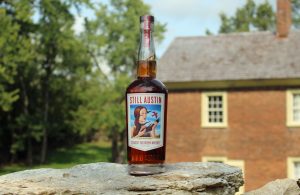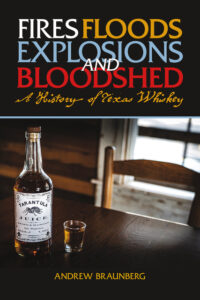By Richard Thomas
 More than a decade ago, I wondered in print that if Kentucky and Tennessee were America’s first and second whiskey states, who was the craft scene propelling to become number three. It took years for the issue to resolve itself, but by the time the Pandemic was clearing up, it had in a way that would stick: Texas was America’s third whiskey state. One small part of the reason why was Still Austin Whiskey Company, and I’m still disappointed that I wasn’t able to travel to Austin this springtime to check them out.
More than a decade ago, I wondered in print that if Kentucky and Tennessee were America’s first and second whiskey states, who was the craft scene propelling to become number three. It took years for the issue to resolve itself, but by the time the Pandemic was clearing up, it had in a way that would stick: Texas was America’s third whiskey state. One small part of the reason why was Still Austin Whiskey Company, and I’m still disappointed that I wasn’t able to travel to Austin this springtime to check them out.
The timing would have been propitious too, as Still Austin co-founder Andrew Braunberg right around the time his new book was coming out. Fires, Floods, Explosions and Bloodshed: The History of Texas Whiskey serves as the prologue to the Texas whiskeys we know today. That book plus Still Austin gave me two reasons to shoot some questions over to Braunberg, who was obliging.
RT: Your passion for whiskey speaks for itself. You not only helped start a whiskey distillery, but you also researched and wrote a book about a pretty obscure corner of American Whiskey history. So, do tell us about how you got bitten by the whiskey bug.
AB: I was a long-time whiskey consumer before I ever thought about trying my hand at distilling. I worked with some guys who had a very active whiskey club and went deep down the Scotch rabbit hole for about ten years. When I got introduced to the craft distilling movement in the US, I decided I really wanted to be a part of developing regional flavor profiles for American whiskey, like they have in Scotland.
RT: It’s my experience that many people in craft whiskey were white collar professionals, jumping over to start a second or third career. Looking over your LinkedIn, your career arc vis-a-vis the old professional job and a career in whiskey looks similar, but also different. Can you walk us through it?
 AB: Yes, I agree with this assessment. I think most craft movements start with early crazy visionaries and attract serious, competent crafts people; next to arrive on the scene are folks looking for something new, and finally those just looking to make a buck, like the current flood of celebrities introducing products.
AB: Yes, I agree with this assessment. I think most craft movements start with early crazy visionaries and attract serious, competent crafts people; next to arrive on the scene are folks looking for something new, and finally those just looking to make a buck, like the current flood of celebrities introducing products.
I consider myself an average smart guy who picks up on things fairy quickly. I have a knack for assimilating and consolidating new information. After high school, I bounced around a bit in construction work and decided I would make a decent engineer, so I got an Engineering Physics, undergrad. Go RPI! But growing up in the DC area, I was a bit of a politics nerd, so I then decided to get my graduate degree in Science, Technology, and Public Policy. I was in science/technology journalism for a while before settling in as an industry analyst covering cybersecurity.
RT: Please, tell me about getting Still Austin off the ground and developing its initial products?
AB: My wife and I co-founded Still Austin Whiskey Co. with two other families. About the only thing all three families ever agreed on was the decision not to source whiskey initially. We wanted to make it from scratch. Now, starting from scratch in Texas is not as hard as it is in other places. We were able to put out an acceptable 1 year old bourbon with help from Nancy Fraley.
Texas is a strong agricultural state, particularly for corn, wheat, and rye. So, it’s pretty natural to want to make bourbon. The co-founders were all fond of wheat, so we started laying down wheated bourbons. Soon, we discovered that they were going to take a while to mature even in the Central Texas climate. So, we started laying down more bourbon with rye as our flavor grain primarily because Nancy convinced us it matures much more quickly – and of course, she was right.
The tasting room was an important part of our early business model, so we needed to have products we could sell while waiting for aged whiskey and bourbon. I ran production at the distillery initially and decided to focus on Gin as our early clear spirit. I set up an R&D team that spent a good six months soley focused on product development. We didn’t want to source GNS, so my wife Lisa suggested we make a light rye whiskey base for the gin, and I think that is one of the reasons it turned out to be unique and successful.
We also decided to produce naturally flavored New Makes (e.g., white whiskeys) that we could use in cocktails to serve in the tasting room. No one ever expected these to be long term products for us but they made decent cocktails and allowed for additional revenue to come into the tasting room during those early years. Starting a distillery, particularly a whiskey distillery, is a huge money sink. You have to be prepared make some tough choices and compromises.
RT: Although it doesn’t surprise me to learn people had stills and were making spirits in Texas, pre-Prohibition Texas whiskey-making isn’t something one hears very much about. It hasn’t even come up in conversations with people making whiskey in Texas today. Without giving too much of your book away, what was the picture like for whiskey-making in World War One era Texas? What were they making and how big of a deal was it, compared to what was going on Back East?
 AB: Many states had thriving distilling histories right up until national Prohibition. While a couple states industrialized their distilleries, particularly Ohio and Illinois, most states remained active but at craft scale. I suspect pre-Prohibition Texas distillers made corn whiskey and wheat-bourbons. New oak barrels were probably very difficult to come by and so used cooperage was likely the norm. There were Texas distilleries that operated for 40 or more years, and so I have every reason to believe they made pretty good booze.
AB: Many states had thriving distilling histories right up until national Prohibition. While a couple states industrialized their distilleries, particularly Ohio and Illinois, most states remained active but at craft scale. I suspect pre-Prohibition Texas distillers made corn whiskey and wheat-bourbons. New oak barrels were probably very difficult to come by and so used cooperage was likely the norm. There were Texas distilleries that operated for 40 or more years, and so I have every reason to believe they made pretty good booze.
What’s interesting in Texas is that the people that did most of the distilling were primarily Southern evangelicals that migrated from Southern and Appalachian states into north-eastern Texas. These were also the first groups in Texas to take up Prohibition and therefore distillery-rich counties started drying out as early as the 1890s. By the time national Prohibition became law most Texas counties had been dry for years.
RT: During Prohibition, a great many folks in the distilling industry took their skills underground and into varying degrees of criminal enterprise. How much of that went on in the Lone Star State?
AB: Texas famously has a frontier ethos and so it is no surprise that there was a good deal of bootlegging going on in Texas. Of course, moonshiners were a problem in the South long before national Prohibition arrived, particularly in the 1870s and 1890s. Texas was called out by the IRS as a state with an active moonshining problem, but it was never a state that saw the violence against revenuers as was the case in much of the mountain South during those decades. And with respect to whiskey, most Texans drank more like westerners than southerners in the sense that aged whiskey was much preferred over moonshine.
There is one funny Texas prohibition story, however, the man considered by many to be the father of US Prohibition, Texas Senator Morris Sheppard. He had a ranch in Texas and during the height of Prohibition, a moonshining operation was discovered on his property. It’s unlikely he knew about it, but probably not a good look for Senator Sheppard.
RT: I imagine you had to do a lot of spade work to pull this book together. What were your most valuable resources?
AB: A great thing about Texas is how very seriously Texans take their history. The State Archives are an amazing and valuable resource and every county in Texas has its own historical societies, many of which are quite active. There is also a national archive facility in Fort Worth where I had good luck.
 The Whiskey Reviewer A World of Whiskey, Poured Every Weekday
The Whiskey Reviewer A World of Whiskey, Poured Every Weekday
